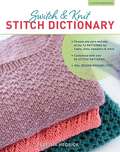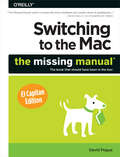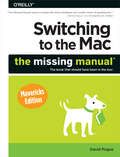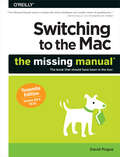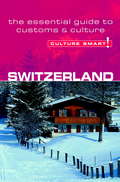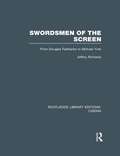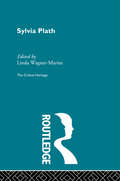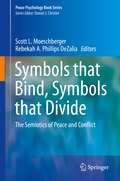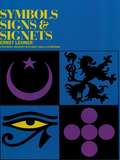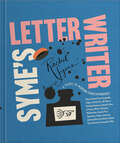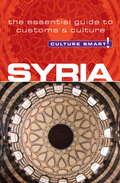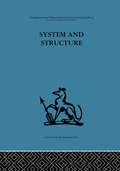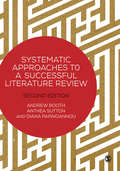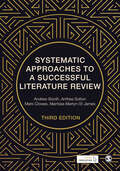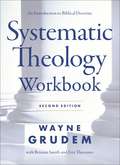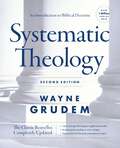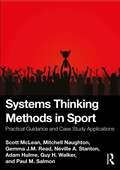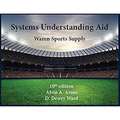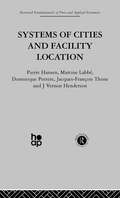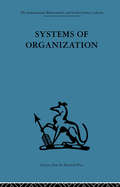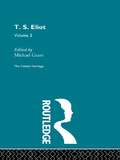- Table View
- List View
Switch & Knit Stitch Dictionary: Choose any yarn and any of the 12 PATTERNS for cowls, hats, sweaters & more * Customize with over 85 STITCH PATTERNS * 700+ DESIGN POSSIBILITIES
by Tabetha HedrickNow it's easy to design your own knit! Start with one of the 12 basic pattern recipes for pieces such as a hat, pullover, shawl, scarf, socks, tee, mitts, tunic, or cardigan. Choose nearly any yarn and a stitch pattern from the 85 4-stitch multiple patterns in the stitch dictionary, and you are on your way to your own unique knitted piece. Make cabled mitts, a lace cardigan, a textured stole, a ribbed pullover, or any of over 700 possible combinations. Best yet, you can knit with any yarn that works to a gauge of 3-8 stitches per inch, so you can use that perfect yarn in your stash you've been saving and design just the right project for it. It is so exciting to make your own one-of-a-kind knits, and this book makes it so easy!
Switching to the Mac: The Missing Manual, El Capitan Edition
by David PogueThose who have made the switch from a Windows PC to a Mac have made Switching to the Mac: The Missing Manual a runaway bestseller. The latest edition of this guide delivers what Apple doesn't—everything you need to know to successfully and painlessly move your files and adapt to Mac's way of doing things. Written with wit and objectivity by Missing Manual series creator and bestselling author David Pogue, this book will have you up and running on your new Mac in no time.
Switching to the Mac: The Missing Manual, Mavericks Edition
by David PogueReady to move to the Mac? This incomparable guide from New York Times columnist and Missing Manuals creator David Pogue helps you make a smooth transition to OS X Mavericks, a beautiful machine with a thoroughly reliable system. Whether you’re using Windows XP, Windows 7, or Windows 8, we’ve got you covered. Syncing with iOS. If you already have an iPhone or iPad, now's the perfect time to switch to OS X with iCloud, which allows you to sync Mail, Contacts, Calendar, Messages, FaceTime, Game Center, Safari, Reminders, iTunes, the Mac App Store, and Notes across all of your devices. Transferring your stuff. Moving files from a PC to a Mac by cable, network, or disk is the easy part. But how do you extract things like your email, address book, calendar, Web bookmarks, buddy list, desktop pictures, and MP3 files? Now you'll know. Re-creating your software suite. The big-name programs (from Microsoft, Adobe, and others) are available in both Mac and Windows versions, and their documents require no conversion on the Mac. But hundreds of other programs are available only for Windows. This book describes the Macintosh equivalents and explains how to move data to them. Learning OS X Mavericks. Once you've moved into the Macintosh mansion, a final task awaits: Learning your way around. Fortunately, you're in good hands with the author of the #1 bestselling guide to OS X.
Switching to the Mac: The Missing Manual, Yosemite Edition
by David PogueWhat makes Windows refugees decide to get a Mac? Enthusiastic friends? The Apple Stores? Great-looking laptops? A "halo effect" from the popularity of iPhones and iPads? The absence of viruses and spyware? The freedom to run Windows on a Mac? In any case, there’s never been a better time to switch to OS X—and there’s never been a better, more authoritative book to help you do it.The important stuff you need to know:Transfer your stuff. Moving files from a PC to a Mac by cable, network, or disk is the easy part. But how do you extract your email, address book, calendar, Web bookmarks, buddy list, desktop pictures, and MP3 files? Now you’ll know.Recreate your software suite. Many of the PC programs you’ve been using are Windows-only. Discover the Mac equivalents and learn how to move data to them.Learn Yosemite. Apple’s latest operating system is faster, smarter, and more in tune with iPads and iPhones. If Yosemite has it, this book covers it.Get the expert view. Learn from Missing Manuals creator David Pogue—author of OS X Yosemite: The Missing Manual, the #1 bestselling Mac book on earth.
Switzerland - Culture Smart!
by Kendall MaycockCulture Smart! provides essential information on attitudes, beliefs and behavior in different countries, ensuring that you arrive at your destination aware of basic manners, common courtesies, and sensitive issues. These concise guides tell you what to expect, how to behave, and how to establish a rapport with your hosts. This inside knowledge will enable you to steer clear of embarrassing gaffes and mistakes, feel confident in unfamiliar situations, and develop trust, friendships, and successful business relationships.Culture Smart! offers illuminating insights into the culture and society of a particular country. It will help you to turn your visit-whether on business or for pleasure-into a memorable and enriching experience. Contents include* customs, values, and traditions* historical, religious, and political background* life at home* leisure, social, and cultural life* eating and drinking* do's, don'ts, and taboos* business practices* communication, spoken and unspoken"Culture Smart has come to the rescue of hapless travellers." Sunday Times Travel"... the perfect introduction to the weird, wonderful and downright odd quirks and customs of various countries." Global Travel"...full of fascinating-as well as common-sense-tips to help you avoid embarrassing faux pas." Observer"...as useful as they are entertaining." Easyjet Magazine"...offer glimpses into the psyche of a faraway world." New York Times
Swordsmen of the Screen: From Douglas Fairbanks to Michael York (Routledge Library Editions: Cinema)
by Jeffrey RichardsThis fascinating study of the genre of swashbuckling films received wide critical acclaim when it was first published in 1977. Jeffrey Richards assesses the contributions to the genre of directors, designers and fencing masters, as well as of the stars themselves, and devotes several chapters to the principal subjects if the swashbucklers – pirates, highwaymen, cavaliers and knights. The result is to recall, however fleetingly, the golden days of the silver screen. Reviews of the original edition: ‘An intelligent, scholarly, well-written account of adventure films, this work is sensitive both to cinema history and to the literary origins of the "swashbuckler"….Essential for any library with books on film, it may very well be the definitive book on its subject.’ – Library Journal
Sylvia Plath (The\critical Heritage Ser.)
by Linda Wagner-MartinThis set comprises 40 volumes covering 19th and 20th century European and American authors. These volumes will be available as a complete set, mini boxed sets (by theme) or as individual volumes. This second set compliments the first 68 volume set of Critical Heritage published by Routledge in October 1995.
Symbols that Bind, Symbols that Divide
by Scott L. Moeschberger Rebekah A. Phillips DeZaliaThis work explores the function of both divisive and uniting symbols in various conflict settings around the world It takes a fairly broad perspective on what constitutes a symbol, to include objects such as flags, signs, language, and monuments, all of which convey conflicting meanings in a society affected by conflict In addition, the authors include commemorations and other dynamic events that serve as a means for groups or individuals to connect with past generations, celebrate a heritage, and possibly express religiosity. In order to provide context for the nuances surrounding the symbols, there are brief historical overviews for each conflict featured in the volume. In each chapter, three issues are emphasized: the particular symbols that are divisive in the specific culture; how these symbols were used to perpetuate conflict; and how these symbols can be used or modified to bring unification. Contributions come from authors from around the world that have conducted empirical studies on intergroup relationships or have provided significant academic contributions in the area of symbols and collective memories represented in theoretical publications Taken together, the contents of the volume provide a rich tapestry of intellectual analyses to the diverse selection of conflict settings from around the globe In addition to the nine case studies, there is an introductory chapter, which grounds the discussion in current peace psychology literature as well as provides future directions. This volume is a valuable resource to many, as the focus on symbols can span many disciplines such as political science, anthropology, sociology, psychology, and art Furthermore, it is of significant interest to all scholars and peace activists studying these various countries and their conflicts.
Symbols, Signs and Signets
by Ernst LehnerReproducing in historical sequence 1355 signs, seals, and symbols from the simplest drawings of heavenly bodies, through the intricate heraldic devices of the Middle Ages, to modern cattle brands and hobo sign language, this book will be of immense value to the commercial artist and designer. The development of man as an artist and designer is here recorded pictorially by one of the world's foremost experts in the field of graphic art, Ernst Lehner.This book is divided into 13 sections, each with a separate brief introduction: Symbolic Gods and Deities (Egyptian, Babylonian, Greek, Germanic, Incan, Aztec, Hindu, Buddhist, Taoist, etc.); Astronomy and Astrology; Alchemy, Magic, and Mystic (Nordic runes, magic circles, etc.); Church and Religion; Heraldry (coats of arms, badges, etc.); Monsters and Imaginary Figures; Japanese Crests; Marks and Signets (engravers, goldsmiths, armorers, stonemasons, etc.); Watermarks (fourteenth-eighteenth centuries); Printer's Marks (fifteenth-seventeenth centuries); Cattle Brands; and Hobo Signs. All the signs, symbols, and signets are pictured in black and white on strikingly laid out pages, with full explanatory notes for both lay readers and specialists.Anyone interested in means of communication other than language will find this book fascinating and authoritative. The student and teacher in the graphic arts will find it a practical visual guide through the transformation of simple marks and signs into the complicated emblems of our time.
Syme's Letter Writer: A Guide to Modern Correspondence About (Almost) Every Imaginable Subject of Daily Life, with Odes to Desktop Ephemera and Selected Letters of Famous Writers
by Rachel SymeA literary jaunt in praise of the lost art of letter writing that explores a cultural history and the undeniable thrill of old-school correspondence—from journalist and cultural critic Rachel Syme.Inspired by a famed correspondence handbook penned by a persnickety Victorian who had strong opinions on how to lick a stamp, cultural critic Rachel Syme has rewritten the staid letter-writing rules of yore for the letter writers of today. Syme insists you must stuff your envelopes with flat frivolities (and includes guides for how to press flowers and make a matchbook-mark), teaches you how to perfume a parcel, and encourages you to cultivate your own ritual around keeping up with your correspondence. Even if you have never sent a hand-written letter before, this book will make you want to begin – and will show you just how to get started.Immerse yourself in this epistolary bric-a-brac celebrating the intimate (whimsical! expressive!) art of written correspondence, covering every part of the process from courting and keeping a pen pal, down to buying the best nibs for your refurbished vintage fountain pen. As you read fragments of letters and journals from storied literary figures—Zelda Fitzgerald, Willa Cather, Pat Parker, Vita Sackville-West, Djuna Barnes, Octavia Butler, to name a few—you can take note of how to write about the weather without being a total snooze, how to write a letter like a poet, and how to infuse your correspondence with gossip and glamorous mystique. You&’ll learn about the magic of hotel stationery, the thrill of sending postcards, and the importance of choosing a signature paper that captures your essence.After all, the words you write on paper and send to another person, are precious, offering comfort, shared sorrow, cathartic rage, hard-earned insight, refreshing strangeness, absurd silliness, understanding, delight, commiseration, and beauty—and often all of those things all mixed up at the same time. Letter-writing is meant to be enjoyed—so pick up a fountain pen and get writing!
Symphonies and Other Orchestral Works
by Donald Francis ToveyOver 100 critical essays about symphonies and other orchestral works from the author.
Syria - Culture Smart!
by Sarah StandishAfter years of diplomatic isolation Syria is emerging from the cold. Its government is a key Middle Eastern player, and will be a major element of any possible comprehensive Middle Eastern peace deal. To visit Syria is to become acquainted with one of the most rewarding destinations in the Middle East. Its historic attractions are stunning, and the Syrians are proud and gracious hosts; you can expect to be treated like a person and not just a tourist. Of course, there are always thorns with the roses: Syria's economy is inefficient, and its youth are frustrated; the strong-man political system that has held the country together does not encourage public intellectual life, but nor does it prevent young Syrians from debating with passion in private. The Syrian sense of tradition has preserved some of the bad along with the good, and society remains highly patriarchal. Despite such drawbacks, this is a country that's rich not only in resources, but also, and especially, in its people. American author Sarah Standish looks at Syria's long history and its present-day political realities. She describes the many subgroups that make up the population as well as what unites all Syrians. She offers practical tips for traveling and on what to expect when conducting business. You'll learn how people communicate with each other, and how you can communicate with them. The Syrians will never stop surprising you: get to know a few, and they will turn the stereotypes inside out several times over.
System and Structure: Essays in communication and exchange second edition
by Anthony WildenTavistock Press was established as a co-operative venture between the Tavistock Institute and Routledge & Kegan Paul (RKP) in the 1950s to produce a series of major contributions across the social sciences. This volume is part of a 2001 reissue of a selection of those important works which have since gone out of print, or are difficult to locate. Published by Routledge, 112 volumes in total are being brought together under the name The International Behavioural and Social Sciences Library: Classics from the Tavistock Press. Reproduced here in facsimile, this volume was originally published in 1980 and is available individually. The collection is also available in a number of themed mini-sets of between 5 and 13 volumes, or as a complete collection.
Systematic Approaches to a Successful Literature Review
by Andrew Booth Diana Papaioannou Anthea SuttonReviewing the literature is an essential part of every research project. This book takes you step-by-step through the process of approaching your literature review systematically, applying systematic principles to a wide range of literature review types. Through numerous examples, case studies and exercises, the book covers often neglected areas of literature review such as concept analysis, scoping and mapping. The book includes practical tools for supporting the various stages of the review process, including; - managing your literature review - searching the literature - assessing the quality of the literature - synthesising qualitative and/or quantitative data - writing up and presenting data Systematic Approaches to a Successful Literature Review is essential reading for any student or researcher looking to approach their literature review in a systematic way.
Systematic Approaches to a Successful Literature Review
by Andrew Booth Diana Papaioannou Anthea SuttonShowing you how to take a structured and organized approach to a wide range of literature review types, this book helps you to choose which approach is right for your research. Packed with constructive tools, examples, case studies and hands-on exercises, the book covers the full range of literature review techniques. New to This Edition: Full re-organization takes you step-by-step through the process from beginning to end New chapter showing you how to choose the right method for your project Practical guidance on integrating qualitative and quantitative data New coverage of rapid reviews Comprehensive inclusion of literature review tools, including concept analysis, scoping and mapping With an emphasis on the practical skills, this guide is essential for any student or researcher needing to get from first steps to a successful literature review.
Systematic Approaches to a Successful Literature Review
by Andrew Booth Anthea Sutton Mark Clowes Marrissa Martyn-St JamesWhether you are new to literature reviews or working with new types of data, this book takes the guesswork out of writing your literature review. From deciding how much literature to include to managing your data, assessing your sources, and writing results, it outlines a step-by-step process that works with any data. To help you choose best approach for your research, this book includes: · Worksheets and decision aids to help you plan and organise your literature review · Worked examples and case studies to show you what – and what not – to do in practice · Troubleshooting tips and answers to all your frequently asked questions · Online access to a literature review starter template, an exercise workbook, project diary template, and a source credibility checklist. The perfect project support for any social sciences student, this edition also includes a new chapter on analysing mixed methods research.
Systematic Approaches to a Successful Literature Review
by Andrew Booth Anthea Sutton Mark Clowes Marrissa Martyn-St JamesWhether you are new to literature reviews or working with new types of data, this book takes the guesswork out of writing your literature review. From deciding how much literature to include to managing your data, assessing your sources, and writing results, it outlines a step-by-step process that works with any data. To help you choose best approach for your research, this book includes: · Worksheets and decision aids to help you plan and organise your literature review · Worked examples and case studies to show you what – and what not – to do in practice · Troubleshooting tips and answers to all your frequently asked questions · Online access to a literature review starter template, an exercise workbook, project diary template, and a source credibility checklist. The perfect project support for any social sciences student, this edition also includes a new chapter on analysing mixed methods research.
Systematic Theology Workbook: Study Questions and Practical Exercises for Learning Biblical Doctrine
by Wayne A. Grudem Erik Thoennes Brianna SmithAn essential resource to support student's learning experience and enhance comprehension of systematic theology.This workbook accompanies the 2nd edition of Wayne Grudem's widely used Systematic Theology. Following the textbook's structure, it features review material and exercises for every chapter, and all major areas of Christian doctrine are covered, including:The Word of GodGodHumanityChrist and the Holy SpiritThe Application of RedemptionThe ChurchThe FutureSections in each workbook chapter include:Opening Prayer: oriented around the content of the chapter to help prepare reader's hearts as they get ready to study and reflect.Chapter Review: questions to help the reader identify and interact with key concepts.Thinking Critically: questions for readers to consider on how the content should influence their beliefs and actions.Personal Engagement: practical application questions that connect theology to daily life.The workbook further maintains the clear writing, friendly tone, and frequent applications to life found in the textbook. Students will benefit from this hands-on engagement with the important teachings in Systematic Theology.
Systematic Theology, Second Edition: An Introduction to Biblical Doctrine
by Wayne A. GrudemThis new edition of Systematic Theology by Wayne Grudem is one of the most important resources for helping you understand Scripture and grow as a Christian.The most widely used resource of the last 25 years in its area, Systematic Theology has been thoroughly revised and expanded for the first time while retaining the features that have made it the standard in its field: clear explanations, an emphasis on each doctrine's scriptural basis, and practical applications to daily life.With nearly 250 pages of new content and revisions, this new edition now includes the following distinctive features:Updated analysis of recent controversies within evangelical theology, including the eternal relationship between the Father and the Son in the Trinity, the role of women in the church, miraculous gifts of the Holy Spirit, and contemporary worship music.New discussion and critiques of recent theological controversies situated outside of traditional evangelical theology, such as open theism, the "new perspective on Paul," Molinism (or "middle knowledge"), "Free Grace" theology, and the preterist view of Christ's second coming.Completely revised chapter on the clarity of Scripture.Completely revised chapter on creation and evolution, including a longer critique of theistic evolution and an extensive discussion on the age of the earth.New discussion of how biblical inerrancy applies to some specific "problem verses" in the Gospels.Additional material explaining evangelical Protestant differences with Roman Catholicism, Protestant liberalism, and Mormonism.Completely updated bibliographies.All Scripture quotations updated from RSV to ESV.Updated section on contemporary worship music.Numerous other updates and corrections.Part of the brilliance of Systematic Theology has been its simplicity and ease of use. Each chapter follows the same structure: discussion of the doctrine being considered, an explanation of that doctrine's biblical support and possible objections, followed by personal application and key terms to know for personal growth. Chapters also include a Scripture memory passage, references to other literature on the topic, and suggested hymns and worship songs.If you think theology is hard to understand or boring, then this new edition of Systematic Theology will change your mind.
Systems Thinking Methods in Sport: Practical Guidance and Case Study Applications
by Scott Mclean Paul Salmon Neville A. Stanton Guy Walker Gemma Read Adam Hulme Mitchell NaughtonSport is increasingly being described as a complex system. This inherent complexity cannot be understood by examining components in isolation; rather, the system as a whole should represent the unit of analysis. Systems thinking is the answer to understanding this complexity and is gaining traction in sport. Systems thinking provides a philosophy and a set of associated methods which can be used to understand and optimise the behaviour of complex systems, such as those inherent within sport.This book presents, for the first time, a practical guide to applying contemporary systems thinking methods in sport as well as case study applications demonstrating how their outputs can be translated in practice. The methods described in this book can be used for better understanding the systemic influences in a broad range of sport contexts, including performance, injury, team functioning, decision‑making, adverse incidents, sports organisation design and redesign, technology implementation, and proactive risk assessments.Systems Thinking Methods in Sport provides a practical step‑by‑step guide for sports practitioners and stakeholders, as well as university students and academics in applying state‑of‑the‑art systems thinking methods to sport.
Systems Understanding Aid: Instructions and Flowcharts
by Alvin A. Arens & D. Dewey WardSystems Understanding Aid 10th Edition Instructions and Flowcharts
Systems Understanding Aid: Reference Book
by Alvin A. Arens D. Dewey WardA comprehensive manual accounting practice set that includes flowcharts, documents and internal controls. Uses a hands–on approach to help students understand basic business documents and visualize information flow in the accounting process. It is used in systems, financial accounting, auditing and capstone courses. Edition Changes: Documents have been modernized and the details of certain transactions have been changed (number of units purchased, number of units sold, selling prices, etc.).
Systems of Cities and Facility Location (Fundamentals Of Pure And Applied Economics Ser. #Vol. 2)
by P. Hansen J. Henderson M. Labbe J. Peeters J. ThisseFirst Published in 2001. Routledge is an imprint of Taylor & Francis, an informa company.
Systems of Organization: The control of task and sentient boundaries
by A K Rice E J MillerTavistock Press was established as a co-operative venture between the Tavistock Institute and Routledge & Kegan Paul (RKP) in the 1950s to produce a series of major contributions across the social sciences. This volume is part of a 2001 reissue of a selection of those important works which have since gone out of print, or are difficult to locate. Published by Routledge, 112 volumes in total are being brought together under the name The International Behavioural and Social Sciences Library: Classics from the Tavistock Press. Reproduced here in facsimile, this volume was originally published in 1967 and is available individually. The collection is also available in a number of themed mini-sets of between 5 and 13 volumes, or as a complete collection.
T.S. Eliot Volume 2: The Critical Heritage (The\critical Heritage Ser.)
by Michael GrantThis set comprises 40 volumes covering nineteenth and twentieth century European and American authors. These volumes will be available as a complete set, mini boxed sets (by theme) or as individual volumes. This second set compliments the first 68 volume set of Critical Heritage published by Routledge in October 1995.
